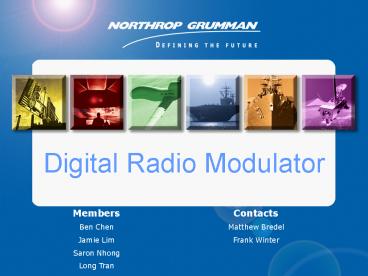Digital Radio Modulator PowerPoint PPT Presentation
1 / 16
Title: Digital Radio Modulator
1
Digital Radio Modulator
- Members
- Ben Chen
- Jamie Lim
- Saron Nhong
- Long Tran
- Contacts
- Matthew Bredel
- Frank Winter
2
Agenda
- Project Objectives
- Modulation schemes
- QPSK, OQPSK, GMSK, 16-QAM
- Systemview Simulations
- ISL-5217 Evalulation Kit
- Experimental Results
- Accomplishments
- Future Goals
3
Objective
- Project Goal Evaluate and program a digital
radio modulator with various modulation schemes
operating at a frequency of 16 MHz - Simulate the system with different filter
coefficients using Elanix Systemview - Program the board with the coefficients and
compare the performance of the various modulation
schemes
4
Overall Implementation of Project
5
QPSK Modulation
- The transmitted equation is given as
- 4 Symbols, 2 bits/symbol
- Signal shifts between the phase states are
separated by 90 degrees - Since the two carriers, cos(wct) and sin(wct) are
orthogonal they do not interfere with each other - Any symbol can transition to any other symbol
6
OQPSK Modulation
Transitions for a QPSK modulated signal
Transitions for a OQPSK modulated signal
- Variation of QPSK
- Q channel is delayed by a ½ bit interval from I
channel - I and Q channel signals transition at different
times - Range of phase transitions is from 0-90 degrees
- This eliminates the 180 degree phase shift so an
OQPSK signal never goes through a zero - In non-linear amplification, a zero causes
regeneration of sidelobes and spectral spreading
in the signal - Thus, OQPSK signals yield a more efficient
amplification process
7
GMSK Modulation
- GMSK can be viewed as OQPSK with a special pulse
shaping filter - GMSK uses constant envelope (no amplitude
variation) - Avoid spectral regrowth
- Improve power transmitter
- Constant envelope occupies larger bandwidth than
modulations that are linear
8
16-QAM Modulation
- Combination of ASK and PSK
- 4 I values, 4 Q values
- 16 possible states, 24 16, so 4 bits/symbol can
be sent - Compared to QPSK, 16-QAM has the same bandwidth,
but increased data rate - More spectrally efficient transmission
- Susceptible to noise and requires linear
amplification - QAM is bandwidth efficient but not power efficient
9
Systemview Simulation
10
Power Spectrum Density (Systemview)
QPSK, OQPSK, 16-QAM
GMSK
11
Systemview I/Q Data
QPSK
OQPSK
GMSK
16-QAM
12
ISL5217 Evaluation Kit
Agilent E4440A Spectrum Analyzer
13
Error Vector Magnitude (EVM)
- EVM compares ideal symbol value with measured
symbol value - Combination of phase error and magnitude error
- Value is normalized to amplitude of the outermost
symbol
14
Experimental Results
QPSK
OQPSK
GMSK
16-QAM
15
Accomplishments
- Successful simulation of modulation schemes
through Systemview - Implementation of filter coefficients into the
ISL-5217EVAL1 Board - By adjusting the number of filter coefficients,
EVM was lowered - ISL-5217EVAL1 Board is ready to be interfaced
with Digital Radio Exciter
16
Future Goals
- Implementation of different filters with
different filter coefficients - Lower the EVM
- Interface with RF Exciter and Predistortion filter

